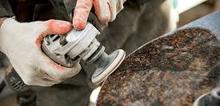Marble has long been praised for its classic beauty and timeless elegance. Marble conveys a sense of grandeur and opulence to any space, from ancient sculptures to contemporary countertops and opulent flooring. Marble, on the other hand, is susceptible to deterioration in the same way that other natural materials are. Over time, it may become dull, stained, scratched, or lose its shine. In this instance, marble restoration comes into play. Everything you need to know about Marble restoration, including what it is, why it's important, how to do it, and how to keep your marble surfaces looking good after it's done, will be covered in this article. What is marble restoration? Marble restoration is the process of restoring marble surfaces that have been damaged, stained, or worn down over time to their original finish and beauty. Cleaning, polishing, grinding, honing, and sealing are just some of the methods used to get rid of flaws and bring the stone back to life. Restoration does more than just make marble look better; it also keeps it from getting damaged in the future and makes it last longer. Whether you need a hotel lobby floor, bathroom vanity, or kitchen countertop restored, professional marble restoration can help. Marble can be damaged in a variety of ways because it is a porous and relatively soft stone. Etching can be caused by acidic substances like vinegar, lemon juice, or cleaning products. Staining: From oils, wine, coffee, or other spills that seep into the stone. Furniture, walking, and abrasive materials are the main causes of scratches and scuffs. Dullness: A dull appearance brought on by frequent use or improper cleaning methods. Cracks and chips: Often due to impact or structural shifts. The appropriate methods of marble restoration can effectively address each of these issues. The steps involved in professional marble restoration typically include the following: 1. Inspection and Evaluation The first step is to assess the state of the marble surface. Experts look for signs of damage, discoloration, or structural issues before selecting the best treatment. 2. Cleaning Deep cleaning removes dirt, grime, and residue from marble with pH-neutral, natural stone-safe cleaners. 3. Grinding, if necessary Diamond abrasives can be used to level out uneven surfaces and remove deep scratches when severe damage is present. 4. Honing The surface is smoothed out and any nicks or dings are removed during honing. In addition, it prepares the marble for polishing. 5. Polishing After being polished, the marble regains its luster and shine. It can appear glossy or satiny, depending on the finish you want. 6. Sealing After the marble has been restored, a high-quality stone sealer is applied to protect it from future stains and damage. Sealing is crucial to maintaining the results of marble restoration over the long term. DIY vs. Expertise in Marble Restoration Although there are numerous kits for cleaning and polishing marble at home, professional marble restoration provides results that are hard to match in terms of precision and durability. Industrial-quality tools and techniques are used by trained technicians to ensure that the work is done safely and effectively. When acidic or abrasive products are used, DIY methods can sometimes do more harm than good. Consequently, for priceless marble installations, professional restoration services are always an excellent investment. Benefits of Marble Restoration restores worn-out surfaces' beauty and shine enables marble installations to last longer Prevents further damage by sealing and strengthening the surface It improves hygiene by removing dirt and bacteria from pores. Adds value to your property or business environment How to Care for Marble After It Has Been Restored To keep your restored marble in pristine condition, follow these maintenance tips: Clean up spills right away to avoid leaving stains. Make sure all cleaners are pH-neutral or stone-specific. Avoid acidic or abrasive products. Under beverages or hot items, use coasters and mats. Depending on how frequently it is used, seal the marble surface every six to twelve months. Where is Marble Restoration Used Most Frequently? Marble needs to be restored in a number of places, including kitchens, bathrooms, fireplaces, spa areas, guest bathrooms, and lobby areas in hotels and resorts; conference rooms and reception areas in office buildings; showrooms and high-end boutiques; and retail spaces. Final Thoughts on Restoring Historic Building Floors and Antique Sculptures Marble restoration is more than just a cleaning process; it is a transformative service that can bring back your marble surfaces' natural beauty and elegance. Restoration can make a big difference in how your space looks and feels, whether you have dullness, stains, scratches, or cracks. By choosing professional restoration services and practicing regular maintenance, you can enjoy the timeless appeal of marble for many years to come
1 Vote
Created


Robin jack at September 09, 2025 at 4:14am MDT
The actual challenge to become is normally you can actually SOLE check out that level of your tax discount over the internet by looking at your RATES web-site. 강남가라오케
Robin jack at September 10, 2025 at 1:09am MDT
Wow Da weiss man, wo es hingehen muss Viele Grüsse Mirta 소액결제현금화
Robin jack at September 10, 2025 at 1:35am MDT
Would you mind basically if I cite a couple of your discussions given that I deliver you credit as well as article sources returning to your webblog? My web portal is in the identical market as your site and my prospects would definitely use some of the advice you actually present at this website. Please let me know if this is okay with you. Adios for now! 신용카드현금화
Robin jack at September 10, 2025 at 5:30am MDT
Hello There. I found your blog using msn. This is a really well written article. I’ll be sure to bookmark it and return to read more of your useful information. Thanks for the post. I’ll certainly comeback. 오피스타